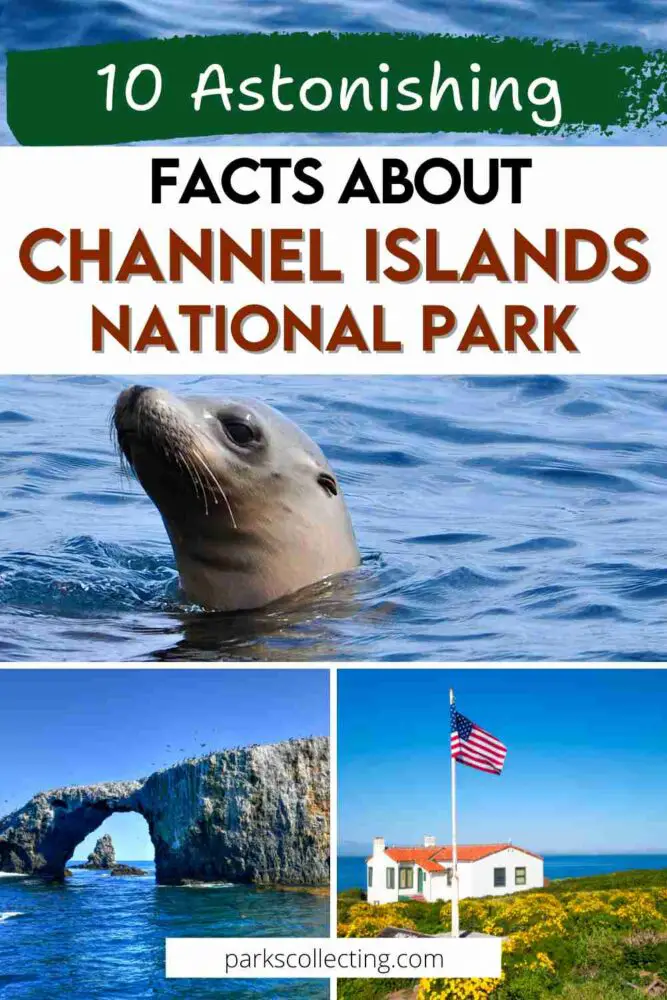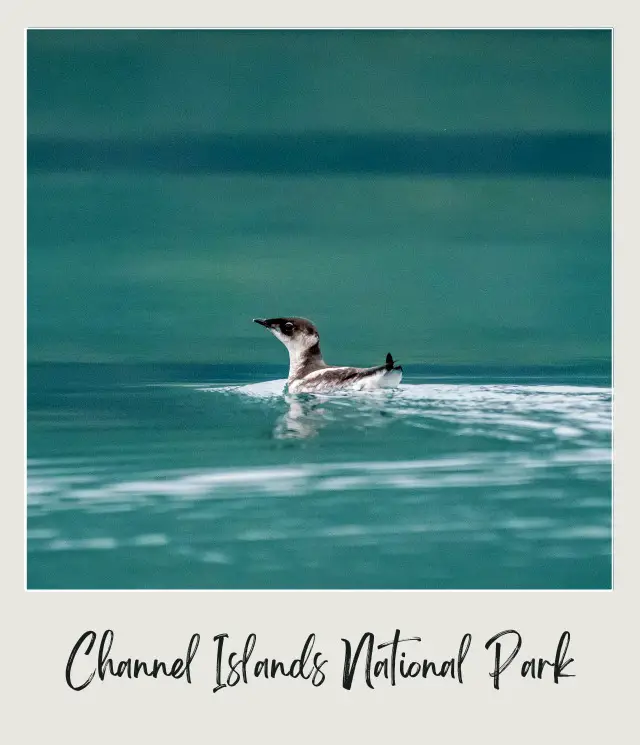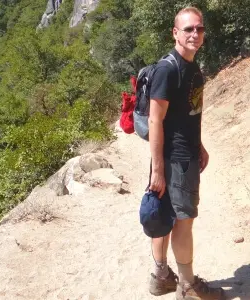Channel Islands National Park is spread over five islands off the coast of southern California. It’s the least visited of the nine National Parks in California, but definitely not the least interesting.
Would you like to learn more about these islands? Let’s take a look at some interesting facts about Channel Islands National Park.
Subscribe to daily national parks planning tips, travel inspiration and trip ideas and I’ll send you a free PDF
Fun Facts About Channel Islands National Park
No time right now to read these fun facts about Channel Islands National Park? Pin It and save it for later:


🛏️TOP HOTEL PICK: Check availability now
🚘FIND THE CHEAPEST CAR RENTAL: Search Discover Cars for the best deals
✈️FIND THE CHEAPEST FLIGHTS: Search Skyscanner for the best deals<
🧳GET TRAVEL INSURANCE: Get insured with Travelex before you go
Table of Contents
Basic Facts about the Channel Islands, California
⭐ Location: It consists of five islands: Anacapa, Santa Cruz, Santa Rosa, San Miguel, and Santa Barbara ff the coast of southern California.
⭐ Size: 249,354 acres, half of which are under the ocean
⭐ Number of Visitors each Year: 328,746 visitors in 2023, making it California’s least visited national park
⭐ Annual Rainfall: About 14 inches per year
⭐ Highest Elevation: 2,450 feet (Diablo Peak | Devil’s Peak)
⭐ Lowest Elevation: sea level
⭐ Date it Became a National Park: President Franklin D. Roosevelt designated Anacapa and Santa Barbara Islands as the Channel Islands National Monument on April 26, 1938. President Jimmy Carter created Channel Islands National Park on March 5, 1980.
10 Fun Facts About Channel Islands National Park
1. The park has the highest concentration of prehistoric sites in North America

The Channel Islands National Park isn’t just a spot for outdoor fun; it’s a window into ancient human history. You might be surprised to know that the Channel Islands have the densest collection of prehistoric sites in North America.
In 1959, the Arlington Springs Man was found on Santa Rosa Island, and these remains are a big deal—they’re the oldest ever found in North America, dating back to 13,000 B.C.
But the prehistoric significance doesn’t stop there. These islands also show us how some of the first Americans mastered the seas, navigating waters in small boats about 12,000 years ago – long before European explorers showed up in the 16th century.
2. There are 145 species of plants and animals in the park that are found nowhere else on Earth

There’s a reason that Channel Islands National Park is often called the “Galapagos of North America.”
The park a hotspot for biodiversity, with 145 species you won’t find anywhere else on the planet.
From the land to the sea, over 2,000 plant and animal species call this place home. The surrounding waters are equally impressive, hosting over 30 marine mammal species.
3. The park boasts one of the most important sea bird rookeries in California

Channel Islands National Park is a seabird sanctuary like no other in California. The park provides a safe haven for the largest breeding colonies of seabirds, including the ashy storm-petrel.
In addition, 99% of the U.S. population of Scripps’s murrelet nest here. It’s a critical site for avian biodiversity, making it a must-visit for any bird-watching enthusiast.
4. Santa Cruz contains one of the largest and deepest sea caves in the world

Get ready to explore one of the world’s largest sea caves at Santa Cruz Island. Painted Cave, named after its colorful rock types, lichens, and algaes, stretches 1,227 feet into the cliffs. Standing at the entrance, you’ll be dwarfed by its massive 130-foot-high arch.
It’s the twelfth-largest sea cave in the world and the second-largest in the USA. However, it’s not the only sea cave in the national park. The Channel Islands have dozens of them. You can even go kayaking along the coast and explore some of them.
And if you’re a movie buff, you might recognize these caves—they were an inspiration for the sets on the Pirates of the Caribbean films.
5. The park is known for its kelp forests

The kelp forests at Channel Islands National Park are underwater jungles, teeming with life and offering a spectacular underwater experience.
These forests are among the ocean’s most productive ecosystems, providing food and shelter for a diverse range of marine life, draw carbon dioxide from the atmosphere, and help to remove nutrient pollution, such as nitrogen and phosphorus, from the ocean.
When you snorkel or dive here, you’re swimming through towering canopies of kelp that rival the grandeur of any land-based forest.
If you dive there, you may well see bright orange Garibaldi fish that live among the kelp. Always take a knife with you when kelp diving – just in case you or your dive buddy get entangled in the kelp.
➡️ READ MORE: Guide to diving Channel Islands National Park
6. The park is a great spot for whale watching

Channel Islands National Park is a prime spot for catching sight of migrating whales.
If you’re looking to spot these majestic creatures, head up the trail to Cavern Point for a panoramic view from above Scorpion Anchorage. Here, you can witness the awe-inspiring gray whale migration from December to mid-March.
And if that’s not impressive enough, every summer, the park waters host the world’s largest aggregation of blue whales, with 10% of the global population gathering here.
7. The park has one of the largest gathering of seals and sea lions in the world

For a wildlife spectacle, San Miguel Island is the place to be.
You’ll find one of the world’s largest gatherings of seals and sea lions here, with species like northern elephant seals, California sea lions, and harbor seals basking on the shore. Over 100,000 marine mammals gather on Point Bennett in the spring, and the sight of their seasonal congregations is something you won’t forget.
8. San Miguel Island was nicknamed “The Graveyard of The Pacific”

San Miguel Island isn’t only famous for its seals and sea lions. It has a notorious reputation, and for good reason.
Known as “The Graveyard of The Pacific,” the westernmost of the Channel Islands is often shrouded in fog, making it a treacherous approach by sea. Over 150 ships and aircraft have met their end near its shores since 1853, a somber reminder of the power of nature and the sea’s unpredictable temperament.
9. Santa Rosa was nicknamed “The Island of The Cowboys”

Santa Rosa Island has a history that’s less about natural wonders and more about ranching heritage. This island was once a bustling ranch, thriving with up to 80,000 sheep and 8,000 cattle.
The island’s pastures and water resources made it one of California’s most successful sheep and cattle ranches, earning it the moniker “The Island of The Cowboys.”
10. Anacapa Island was a speakeasy in the 1920’s

Step back into the 1920s on Anacapa Island, where the prohibition era brought bootleggers and secret bars to life. Prohibition (when alcohol was illegal) existed in the United States from 1919 until it was repealed in 1933. This led to the rise of ‘bootleggers’ – people who made and sold liquor – and ‘speakeasies” (bars or restaurants that illegally sold liquor).
Ira and Margaret Eaton ran a resort on Santa Cruz Island that served sailors, fishermen and film crews more than just food -it also doubled as a speakeasy.
They didn’t just pour drinks; they stored bootlegged liquor, sneaking it into Southern California ports. Anacapa Island’s speakeasy history gives it a unique twist among the Channel Islands, painting a picture of a time when the island was a hub for those looking to skirt the laws of Prohibition.
Subscribe to daily national parks planning tips, travel inspiration and trip ideas and I’ll send you a free PDF
Fun Facts About Channel Islands National Park
More Information About Channel Islands National Park
Are you feeling inspired to visit Channel Islands National Park? Start planning your trip now with these guides:
⭐ Planning A Trip to Channel Islands National Park: 7 Mistakes to Avoid
⭐ Channel Islands SCUBA Diving, California
⭐ How to Get to Channel Islands National Park
⭐ Closest Airport to Channel Islands National Park
⭐ The Airports Near Channel Islands National Park
⭐ Best Time To Visit Channel Islands National Park
⭐ Visiting Channel Islands National Park: What To Expect Throughout the Year
⭐ 10 Tips for Visiting Channel Islands National Park
Do you have any other fun facts about Channel Islands National Park to share? I’d love to hear them. Join my private Facebook group National Parks Collectors and comment and let me know (you can also pick up extra planning tips, share your photos and stories with other national park lovers and more).
If you liked this article, Pin It to your Channel Islands National Park board!


💡 Are you just starting to think about taking a national parks trip? Get Inspiration
‼️ Are you looking for helpful tips for visiting US national parks? Read articles that share useful tips on a range of national-park related issues
💻 Are you starting to plan a trip to Channel Islands National Park? Read my Guide to Channel Islands National Park
💲 Are you ready to book your trip? Use these Planning and Booking Resources
📖 Do you want to read a book about US national parks? Check out my Recommended Reading Lists
About the Author

James Ian is a national park, camping and hiking expert.
He has dedicated his life to travel, visiting more than 80 countries, all 7 continents and most of the national parks in the United States. With over 35 years experience in the travel industry, James has worked on cruise ships, at resorts and hotels, and as a travel planner who’s helped hundreds of people plan successful trips to US national parks.
Based on his experience visiting our national parks multiple times, in-depth research and expertise as a travel planner, James has published detailed itineraries for many of the major national parks in the US. These itineraries, as well as in-depth park guides, and other resources will help you have your own incredible trip to US national parks without stress and hassle.
As a national park expert, James has contributed to many publications, including USA Today, Newsweek, Time Business News, Savoteur, Best Trip, and Wired.
I’m a member of the Amazon Services LLC Associates Program. As an Amazon Associate I earn from qualifying purchases.
